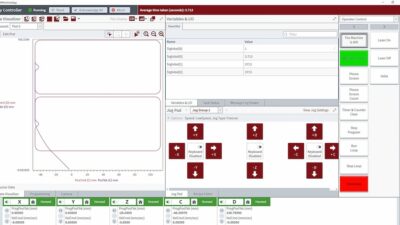To give control and automation users more "openness and integration," Profibus International (PI, Karlsruhe, Germany) unveiled its ProfiNet strategy at an Aug. 10 press conference here. The organization describes ProfiNet as an "open, transparent coupling" of Ethernet TCP/IP at the automation systems level and Profibus at the field level.
To give control and automation users more “openness and integration,” Profibus International (PI, Karlsruhe, Germany) unveiled its ProfiNet strategy at an Aug. 10 press conference here. The organization describes ProfiNet as an “open, transparent coupling” of Ethernet TCP/IP at the automation systems level and Profibus at the field level.
PI states its announcement illustrates its move towards being a broader-based organization for industrial communications and automation using an “open integration” strategy. The organization says, “End-users are looking for the linking of Profibus at the field level and Ethernet in the distributed control system environment in an uncomplicated way that guarantees open, transparent communications between software applications at all levels. This will be achieved using open industrial standards, such as TCP/IP, COM/DCOM, Remote Procedure Calls (RPC) and OLE for Process Control (OPC) technologies.”
PI adds this goal will be achieved with a manufacturer-independent solution enabled in three steps:
-
Mapping Profibus cyclic and acyclic engineering services onto TCP/IP, giving access to process variables, parametrization and diagnostic data, and the definition of a corresponding software interface for OPC. This will allow users to monitor Profibus devices remotely via Ethernet and the Internet and make factory data accessible to popular office software applications.
-
Direct routing of TCP/IP onto Profibus, enabling Internet technology and Microsoft software to become more integrated with field devices. This will enable web servers in field devices, and allow more complex field devices to use common services via DCOM.
-
Direct connection with the Internet, “effectively fusing” Profibus and Ethernet TCP/IP. Complex field devices, such as drives, are already distributed, object-oriented systems, and these will have appropriate services on-board. Less complex field devices will be integrated using OPC proxy-servers. PIs says its vision is: “To provide close co-operation between standard, decentralized field devices and more complex systems in this arena.”
In a presentation at the Profibus Trade Organization’s (PTO, Phoenix, Ariz.) general assembly meeting on Aug. 2, Egon Hillerman, of Siemens Energy & Automation (Alpharetta, Ga.), reported that ProfiNet can be used in both automation and office worlds. He adds ProfiNet’s aim is “open, distributed automation” that avoids the fieldbus squabbles of recent years.
Besides using an automation object model enabled by COM/DCOM; communications based on TCP/IP; and object handing and HMI using OPC, Active X, and XML, ProfiNet also will include a component editor that defines objects and aids communications between intelligent devices. This will further ease configuration by lessening the need for explicit programming. In addition, the proxy method ProfiNet uses to link Ethernet and Profibus will allow numerous other devices to fit into the strategy.
Mr. Hillerman adds that ProfiNet will be offered as an open source to all interested parties. “ProfiNet allows open communication between Ethernet and any fieldbus system. This should prevent continuing fieldbus wars by proprietary protocols on the Ethernet level,” says Mr. Hillerman. “By using open standards, Profibus International is setting the basis for fast, worldwide acceptance of ProfiNet. We want to cooperate with all fieldbus organizations.”
“We’re not trying to package Profibus over Ethernet. This is a gateway between them. Each will retain its own physical layer. This is how Profibus will work with Ethernet—via an open architecture that will allow them to talk together,” says Mr. Hillerman.
Some members at PTO’s general assembly projected that just being able to talk over a network wouldn’t necessarily lessen wiring or equipment requirements, speed up communications, or reduce costs significantly. Other attendees questioned the wisdom of basing ProfiNet on DCOM because Microsoft plans to phase it out soon. However, several PTO officials say a transition strategy is needed now, and they estimated it would be a simple procedure to update ProfiNet using Microsoft NT or 2000 platforms, as well as use other upcoming communication standards.
First products using ProfiNet will likely be launched at Hannover Fair in April 2001.
For more information, visit www.profibus.com , or www.controleng.com/freeinfo .



